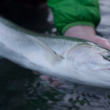Anglers are drowning in gear choices—rods, reels, boots, waders, lines, packs, bags, boxes, vests, apparel and more. It seems harder and harder to know what's worth coveting and what's worth ignoring. Gear reviews are a great way to explore in-depth what might be right for you, but not every piece of gear is suited to a full-length review and, even if it were, there's simply too much of it to get to. With that in mind, we periodically showcase what's working for us right now, to hopefully offer more helpful feedback on gear that's worthy of your attention.
All gear is welcome here: new, old, cheap, pricey, and so on.
The goal is to provide useful feedback on gear that works—not to help gin up marketing for new products. Sometimes, great gear has just hit the market, other times it's been here doing good work all along.
As always, our feedback comes with a promise: Unlike many magazines that publish gear roundups for products they've never so much as seen in person let alone put to work, we've actually used and field tested every piece of gear we write about.
Scott Session 9’ 5-weight fly rod
Why aren’t more people talking about this rod? Perhaps it’s just the particular niche I’ve been occupying in the world of fly fishing the last year or so, but it seems like the chatter surrounding Scott’s relatively new line of Session fly rods (pictured at top) has been less than one would expect.
I suppose we here at Hatch Magazine are partly to blame for this, as the magazine is one of numerous outlets yet to produce a full-length review of the Session. Partly, that’s because in the many months I've been fishing the 9-foot 5-weight Session, I'm still trying to figure out what to make of it.
Scott has introduced a series of well-loved and lavishly praised rods over the last decade or so. The Scott Centric, the Sector, the Meridian, and the Radian are just a few examples. All flagship fly rods, with flagship price tags. Casters oohed. “Experts” gushed.
Most recently, the Montrose, CO-based rodmaker introduced the Session lineup at a mid-range price point and the industry said ... well, not enough. The reason that’s had me so perplexed is because here’s the truth: Ignore the price tag. For my angling, the 9-foot 5-weight Session might just be the best rod Scott has made since (and maybe even including) the aforementioned Radian. It’s certainly the most fun to cast and fish.
There will be more to say about the Scott Session that probably should already have been said, but for now, suffice it to say this is a medium-fast rod that bends pleasingly deep into the blank, flexes the way fly rods used to, is wonderfully responsive and versatile, is a joy to cast, and is $300-400 less than a lot of fly rods I’d pass by to pick up the Session.
If my kids were into fly rods, they’d say it “eats.” Five weights are fun again. Woohoo.
— Chad Shmukler

Orvis Widemouth Hand Net
I’ve always had a hard time paying up for a net, because I inevitably lose or break them. When I got hold of the Orvis Wide-Mouth Hand Net, though, I changed my mind. It’s $149, but this net is leaps and bounds better than any of the other hand nets I’ve used.
It’s only 25.5 inches long, which is the perfect size for hanging off the back of my chest pack while wading. The handle is just under ten inches long, which gives me enough reach to net fish without worrying that I’ll tip over and fall in the water.
This net’s best feature, however, is its bag. The bag is 9.5 inches deep, which makes scooping up bigger trout a piece of cake. A lot of hand nets have shallow bags that are overwhelmed if you try to net anything larger than 15 inches. This bag is knotless and hook-resistant, and of course it’s rubber-coated, so it’s great on the fish. Orvis doesn’t publish a weight, but I’ve not noticed it hanging off my back, unlike my previous wood nets. If you’re going to get a nicer net, I’d be hard-pressed to recommend something other than this.
— Spencer Durrant
BUY THE ORVIS WIDE MOUTH HAND NET

Thermapen ONE Thermometer
Fly fishers are not known for being particularly trustworthy. A two pound smallmouth bass magically becomes a three pound smallmouth bass on the way home from the river. A 13 inch rainbow trout somehow morphs into a 16 inch rainbow trout. At the same time, the more devious among us will declare that an 18 inch brown — and you’ll want to think about this one for just a second — is a 15 inch brown.
We tend to play fast & loose with the truth. As Ed Zern once noted in Field & Stream, “fly fishermen are born honest, but they get over it.”
I don’t really mind when other anglers stretch the truth, but I want an honest thermometer. If the water temperature is 67 degrees, that’s what I want my fishing thermometer to read. I don’t want a thermometer that’s off by a degree, or two, or three, or five. And based on a bit of research a few years back, thermometers — or at least fishing thermometers — are about as trustworthy as fly fishers themselves.
Which is why I’ve been using a Thermapen One from ThermoWorks for the last three or four years. It’s very fast, it’s very accurate and it’s super convenient. If you care about accurate water temperature readings, and if you don’t mind spending more money for a quality product, it’s a really solid choice.
— Todd Tanner

Benchmade Knives Water Series Mini Adara pocket knife
Benchmade is a legacy knife brand that unquestionably produces quality blades that are built to last a lifetime. But, as an angler, I’ve always considered Benchmade to be more a hunter’s company — it produced knives that are great for gutting game or dressing grouse. Now, though, the company is producing its new Water Series knives, and, after carrying one around for a few months and purposely using it in wet, fishy situations, I’m quite impressed. My favorite of the new Water Series is the Mini Adara, a clip-equipped pocket-knife that just continues to impress. It’s easy and safe to unfold and it is very sturdy. The blade has retained its edge (even after cutting pike leader in the Yukon earlier this summer), and it’s easily the most comfortable folding blade I’ve ever used. It’s big enough to handle significant tasks — when it’s open, it’s more than 7 inches long — and compact enough to drop in a dry bag or the pocket of my waders when it’s closed. I give it my complete endorsement, and I know Benchmade’s lifetime warranty will ensure that the knife will be with me for years to come.
-— Chris Hunt

Orvis Bug Out Backpack/Chest Pack Combo
I’ve had an Orvis Bug-Out Backpack, and the new Orvis Chest Pack, since they were released a few years ago. I’ve since become a devoted chest pack angler, but it’s the combo of these two products together that really stands out.
The Bug-Out Backpack is a 25L pack with a dedicated laptop sleeve (which Orvis says can accommodate a hydration bladder, too), a zippered side-entry panel, integrated net storage, and a few extra pockets on top for your phone, keys, and snacks. The straps have docking stations for attaching nippers, retractors, and other gear. The big draw for me, though, is the water bottle pocket that extends long enough to hold a rod tube. It’s a genius piece of engineering that works as well as advertised.
The Bug-Out is comfortable for long hikes — I wear it on all my day trips — and fits perfectly as a carry-on when flying. I’ve flown with this on multiple airlines and never had a problem. In fact, the bag is such a great size I end up using it off the water, as well. I loved it so much that I just bought a new one after my puppy chewed through the zipper on my original.
The Chest Pack has a built-in tippet spool, which is my favorite feature. Inside there’s enough room for five or so fly boxes (depending on how big yours are) and a half-dozen indicators. What I love, though, is that the Chest Pack clips directly into the straps on the Bug-Out Backpack, giving you the perfect day-trip bag. I’ve worn this on long treks in the Wind River Mountains, or on afternoons with my wife and the dog while perusing high country meadows. It’s a wonderfully functional pairing of gear that works better than I think anyone anticipated.
— Spencer Durrant
BUY THE ORVIS BUG OUT BACKPACK
Royal Wulff Bermuda Shorts Triangle Taper fly line
To say casting the Royal Wulff Bermuda Shorts fly line was a revelation might be a bit over the top. But, on a spring trip to the flats of Roatan, this tropical, triangle-taper line with a 22-foot head made an actual difference in my casting. Not only was able to lay out accurate casts in the tropical wind, but the 7-weight line helped turn over longer leaders for some sometimes-spooky bonefish. Better yet, the Bermuda Shorts line made it easy to pick up and recast with minimal effort. Over the course of a week in the tropics, I grew to absolutely love this fly line — I’ve got Royal Wulff bookmarked for the next big flats challenge. You should, too.
— Chris Hunt





























Comments